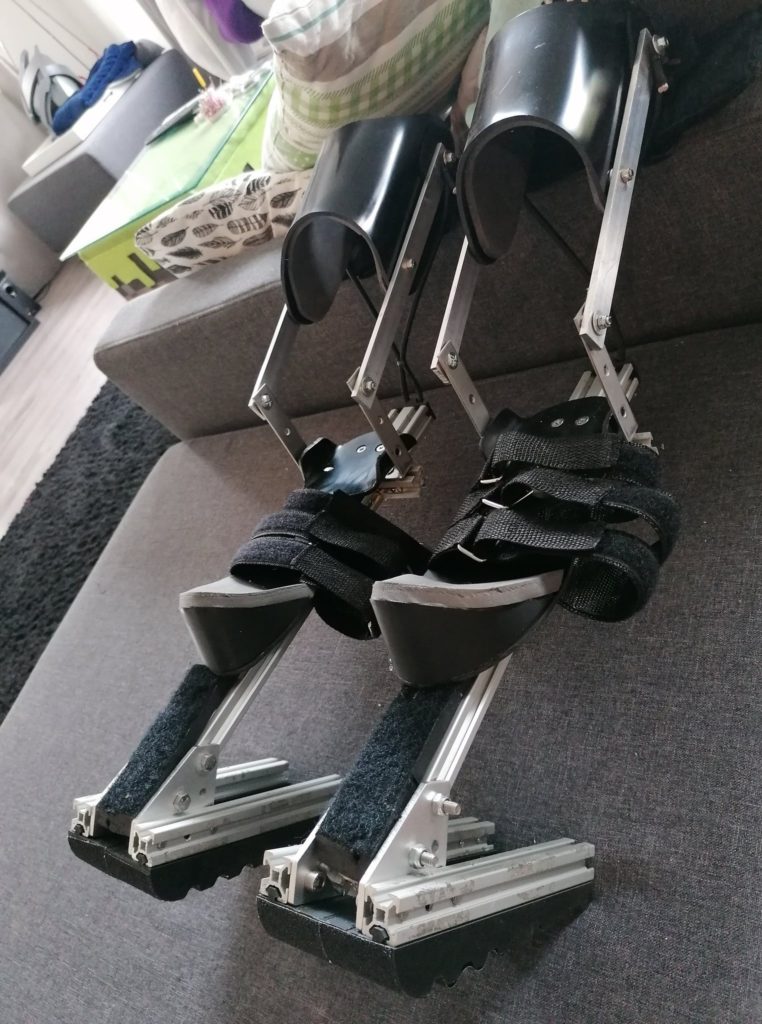I do not sell these or make any stilts for sale!
This describes my build of digitigrade (digilegs) stilts for my Kerapac costume and future costumes. Check out my feed on my social media pages to see them in motion!
They’ve gotten a couple QoL updates based on my first experiences, they’re either noted throughout the document, and again described at the end.

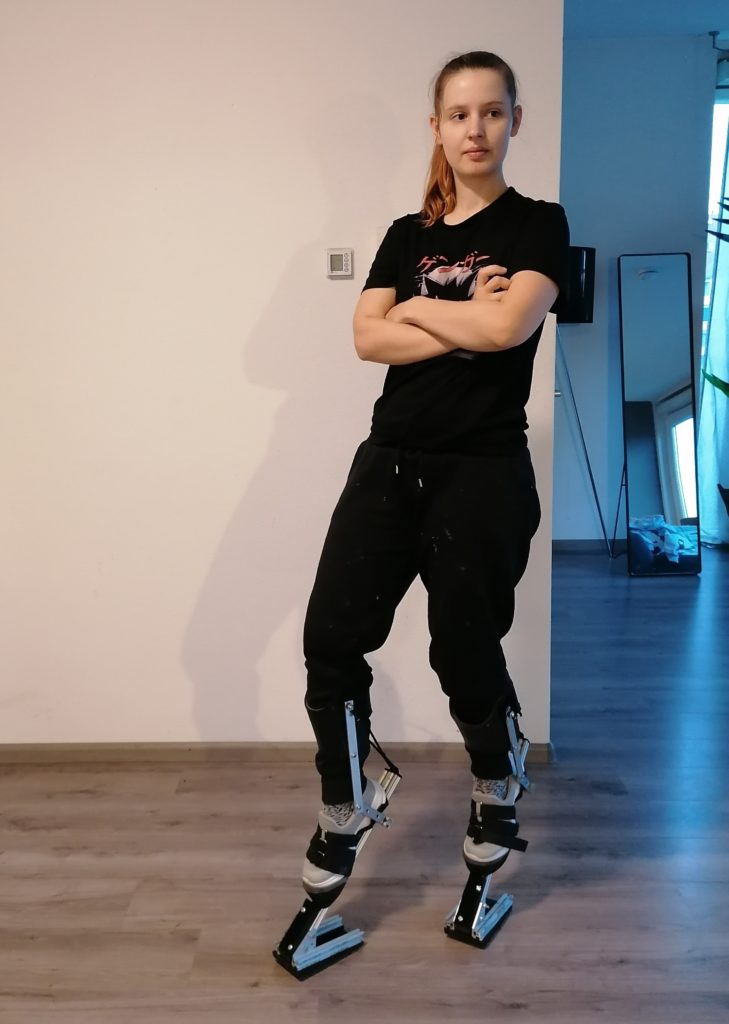
For these stilts I used the following tools:
Power drill with M5 and M6 metal drills (HSS drills)
Tap and die set (tap size M6)
Jig saw (for the ABS plastic sheet)
Metal handsaw
I used the following hardware:
2x Aluminum 2040 profile 450mm
4x Aluminum 2020 profile 180mm
4x Aluminum joining plate 90 degrees
4x 250mm Aluminium slats 20x5mm (get 300mm if youre taller)
4x 100mm corner brace (stainless steel!)
4mm ABS plastic sheet
I used the following bolts and bits:
~40x 25mm M5 bolt
~20x M5 locknuts
Bunch of wide washers that fit M5
8x 60mm M6 bolts (stainless steel)
5mm thick bungee cord
For the straps I made my own using:
25mm wide nylon webbing
50mm wide nylon webbing
20mm wide velcro
50mm wide velcro
6x rectangle D rings for 25mm
2x rectangle D rings for 50mm
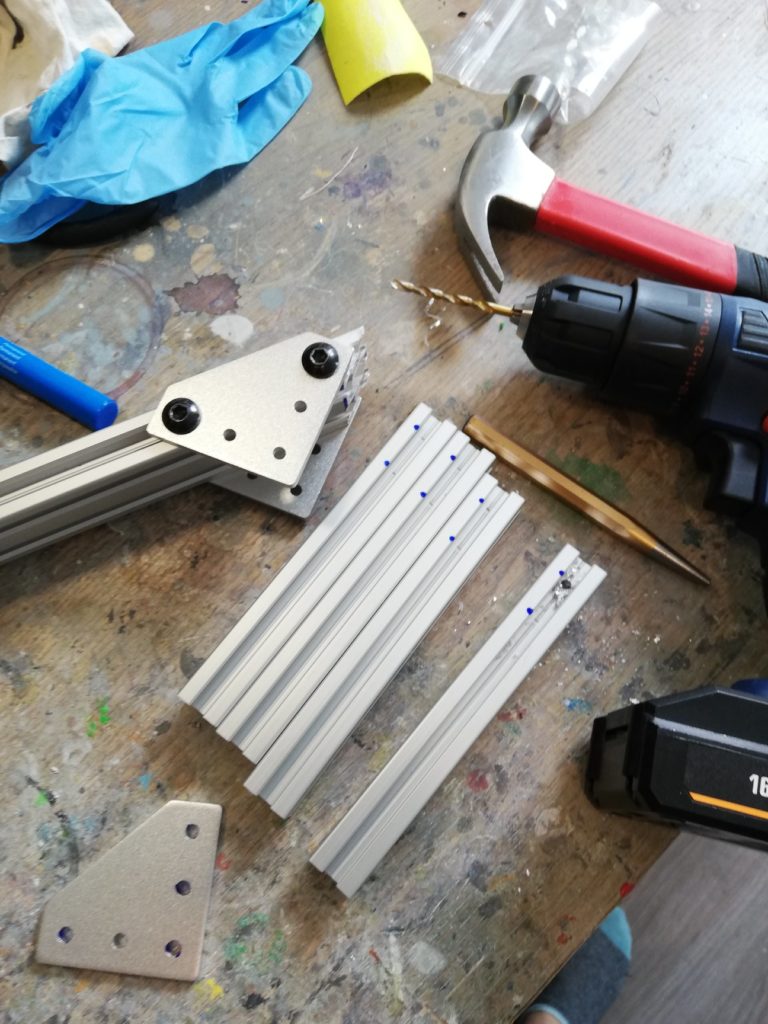
I started on the base. I didn’t get the 2040 profiles cut to size, so I sawed 2x 450mm 2040 profiles from one piece of 900mm with one side 45 degree corner. The angled cut is necessary for mounting later.
I got the 2020 profiles cut to size (180mm) from the same store (aluxprofiel.nl).
Using the holes in the 90^ joint plate I marked where i need to drill the aluminum profiles. Use a centerpoint I hammered a hole in the profiles and then I drilled them with my power drill in size M5.
Then I tapped the holes using an M6 tap and die set which leaves the holes threaded and then I could use my M6 stainless steel bolts to bolt everything together.
Note: I later mounted these 2040 profiles under a steeper angle of ~55 degrees instead of the 45 degrees imposed by the joining plate. I drilled an extra hole in the joining plate to accommodate.
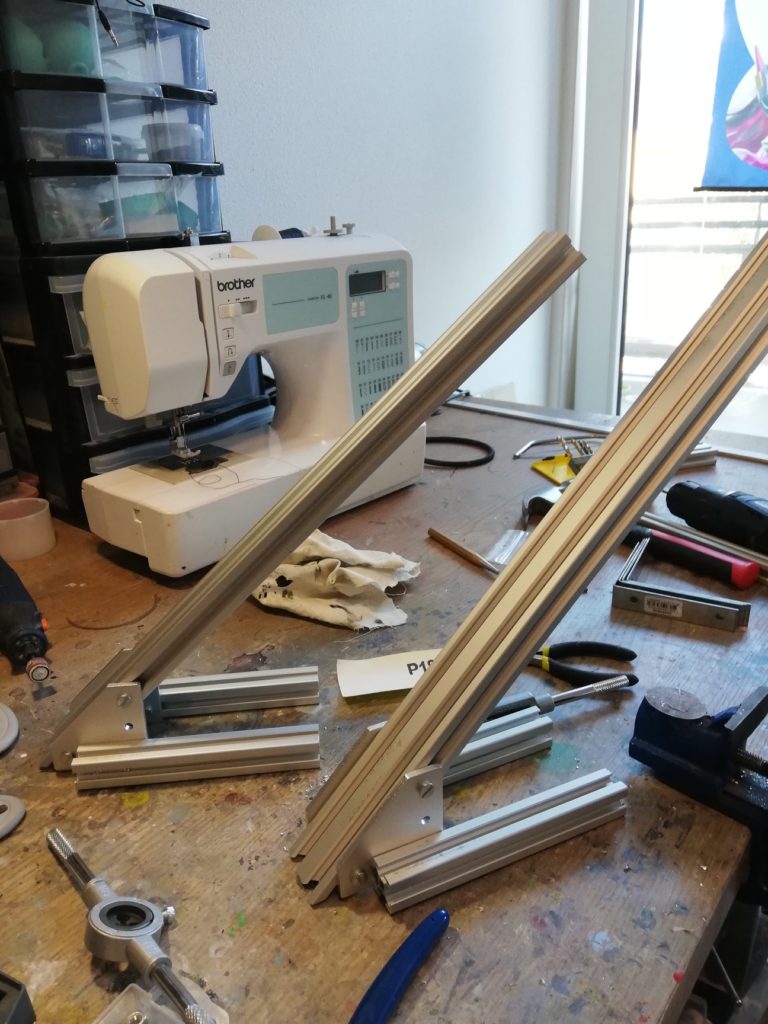
I mounted the smaller 2020 side profiles on the outside which makes the point of contact with the ground much wider and more stable. They were also drilled and then tapped.
Once the base was put together I figured out the joints for the shin support. This basically acts as a backup achilles heel.
I bought some steel corners from the construction store, then replaced them later with stainless steel corners. They were mounted on top of the 2040 profiles near my ankles, by drilling and tapping two holes through the profile and the corners to match up the width of my ankle.
The photo shows the old setup, where I bent the braces around the profile and then bolted them down, but these aren’t strong enough to support the shin without bending.
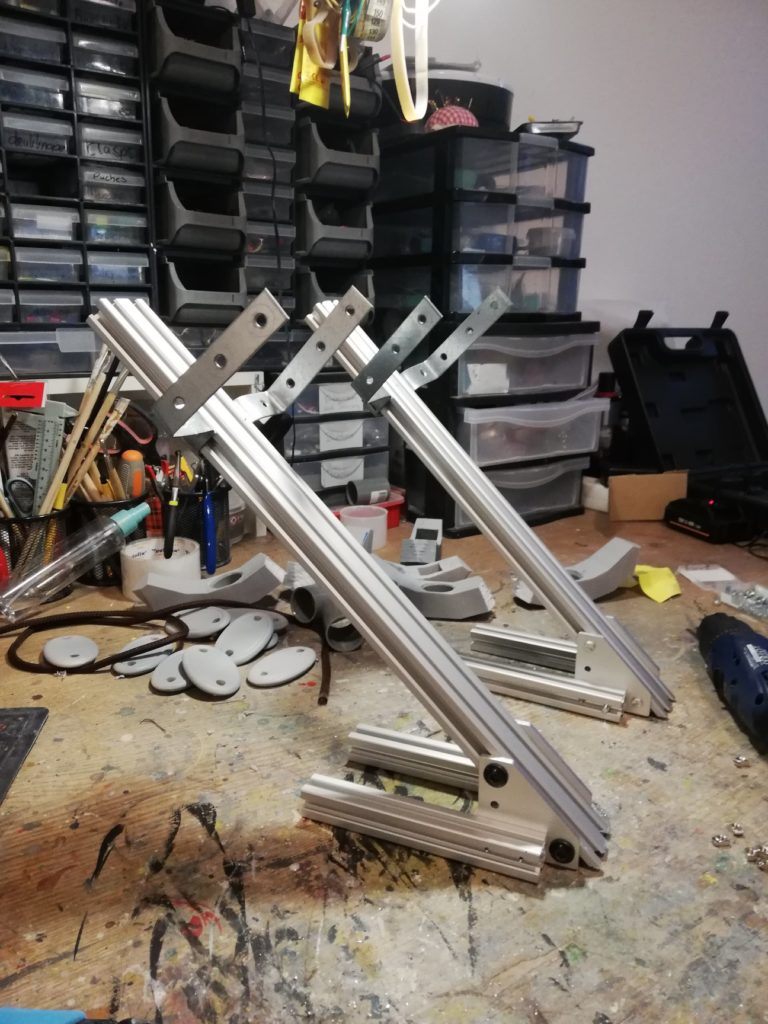
I added 250mm long 5mm thick aluminum slats. I had to cut these to size by hand and I bought 1 meter so for second time i would have picked a little longer (~300mm) to provide more support further up the leg, especially if you’re taller.
I drilled both ends using M5 drill (no need to tap them) and mounted them to my steel corners with my M5 bolts and locknuts to prevent the nuts from falling off. Some washers were placed inbetween.
I drilled two holes for my bungee cord on the core 2040 profiles, and looped the bungee cord through the end, ziptied it in the middle. The ends of the bungee cord were then looped around the bolt to the top of the aluminum slats, tightening the loop again with a ziptie. |
Feedback adjustment: The bungee cord frayed a bit after extensive use because of the drilled holes, so later I 3d printed a loop instead, and bolted it to the end of the profile using the tapped holes in the profiles.
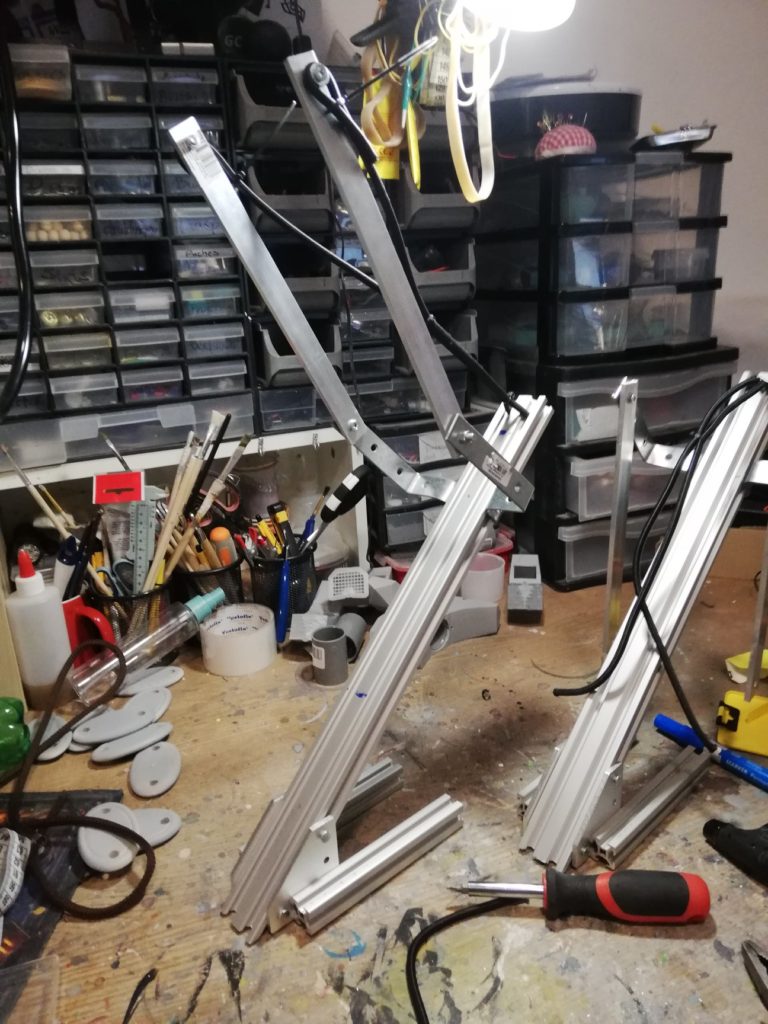
That’s pretty much the base frame complete,
I used an electric jigsaw to saw some foot plates from 4mm abs sheet.
I drilled 4 holes through the foot rest plates, and through the frame using an M6 drill, and used very long countersunk bolts to bolt the foot plate and the straps to the frame all at the same time, with locknuts at the bottom. I used some of the wide washers so the nylon straps would not pull off the bolts.
I used a countersunk drill and some spare pieces of abs plastic to thicken the foot plate to make sure the heads would not protrude through my soles.
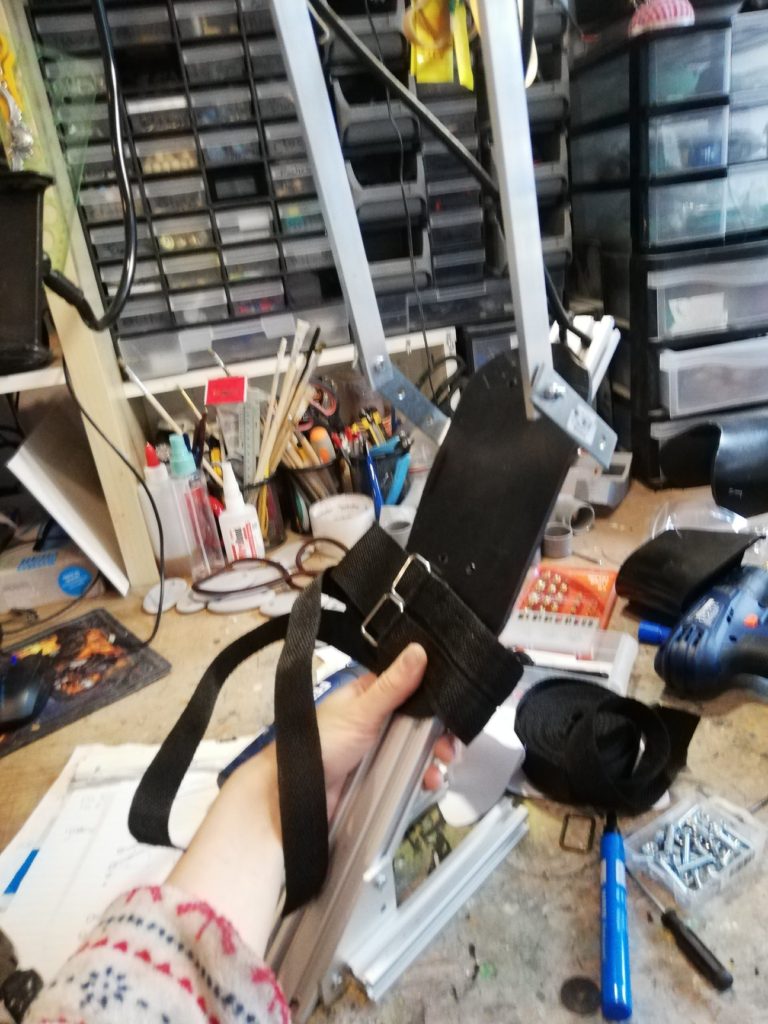
FEEDBACK ADJUSTMENT: I added 3D printed and foam toe rests, simply superglued to the footplate of ABS plastic.
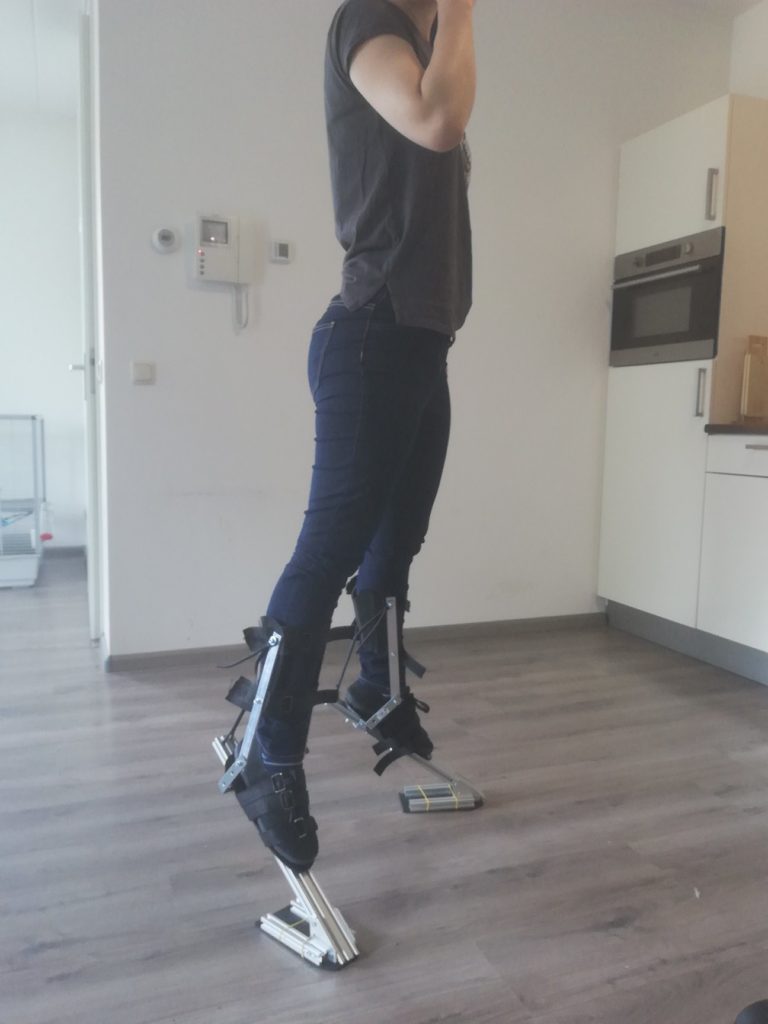
To create the shin support I sawed out 2 more ABS plastic sheet shapes to support my shin on one side, and then straps on the calf side. The pieces were heated to a C shape with a heatgun. And then bolted into place to the aluminum slats.
Last I added the straps and plates for my legs to sit in. I sewed my own straps from some nylon webbing, velcro and D rings I had left over. I doubled up the nylon straps for comfort and strength. I added one wide strap over the roof of my foot ( as far up as possible) and one wide strap across the calves. I added one thinner strap across the toes. They were fastened inbetween the bolts used to mount the foot plates and the chin plates. Some washers were placed inbetween to prevent fraying to the point they could fall off, and the holes in the nylon straps were burned with a lighter to prevent fraying aswell.
I then tightened the bungee cord ends at the top bolt for the chin support, inbetween some washers, and instead of making a knot, i used zipties to fasten them into a loop.
FEEDBACK ADJUSTMENT: The ABS plates for my calves were later inverted to be placed on my shins instead (the picture shows it on the calves). A layer of 5mm eva foam was added to the abs plates for comfort.
Feedback adjustments that were made after initial tests and extensive use:
I noticed some bolts may wear out quickly or even bend due to the force exerted on the toe area and changed all of those bolts to stainless steel (it was galvanised steel before).
Due to some missed steps on a long day of intensive use, the galvanised ankle joints (the corner braces) were bent. I switched them out for the exact same 100mm chair corners, but in stainless steel.
Basically just use stainless steel for everything rather than galvanised steel, it’s a lot stronger.
I 3D printed toe rests (basically a 45 degree angle block that fits the foot rest) for comfort. Added some eva foam on top of that aswell. You can use wood, plastic, foam etc too.
I also bolted high density eva foam pieces to the bottom of the stilts using sliding T-nuts, this makes it softer, less noisy and easier to walk (and doesnt damage floors).
I 3D printed a loop for the bungee cords and bolted that to the back of the main 2040 profiles, as the bungee cord was slightly frayed by using raw-drilled holes in the metal.
Some velcro was added to the front and back to easily attach skins for costumes.
These additions are not necessary but may improve comfortability/modularity, you may be able to find some suitable alternatives with other material/repurposed items.
